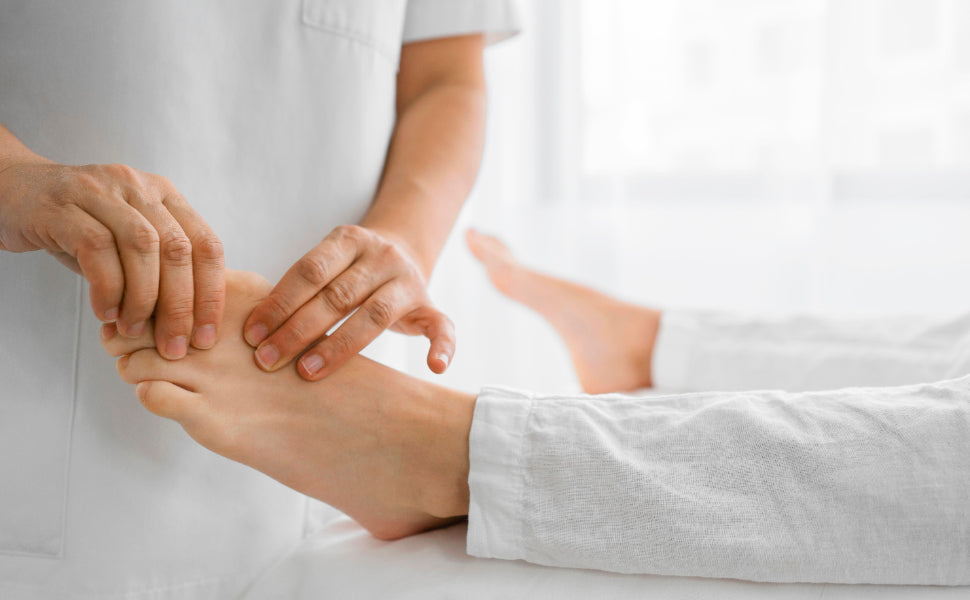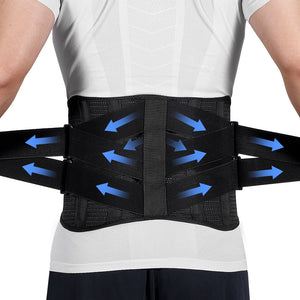Do Bunion Correctors Really Work?

Bunions affect 23%[1] of 18-65-year-olds and 36% of over-65s. Medically defined, bunions are bony protrusions at the big toe metatarsophalangeal joint, commonly caused by hallux valgus. Due to inflammation and joint misalignment, swelling, redness, and severe pain are common. Consequently, bunions make walking, standing, and wearing shoes uncomfortable, limiting everyday activities. Chronic pain and stride changes may cause calluses, bursitis, and hammertoes. Along these lines, bunion toe correctors help relieve pain and straighten the foot.

How Bunion Correctors Function
Basic Principles behind the Corrective Mechanisms of Bunion Devices
Bunion correctors work on the principle of mechanical realignment. With gentle and consistent pressure, these devices counteract the lateral deviation of the big toe (hallux valgus bunion). They provide static and dynamic correction. Static correctors are worn when the foot is at rest, including during sleep. On the other hand, dynamic correctors are used during walking or other activities. The mechanism uses splints, toe spacers, or braces that help reposition the metatarsophalangeal joint. The corrective realigns the joint to avoid pain and further deformation. Moreover, the devices may incorporate cushioning elements to ease pressure points and distribute weight across the foot. With alignment and cushioning, bunion toe correctors help manage bunion-related issues.
Types of Toe Bunion Correctors and Their Specific Functions
First of all, night splints are rigid devices worn during sleep for proper toe alignment over long periods. They prevent further deviation with a sustained corrective force. Ankle Brace for Bunion with an adjustable button, heel straps and silicone pads relieve patients’ foot pain, even the force, and prevent itself from shifting. Daytime correctors, including gel toe separators, are softer and worn with shoes. They help keep toe separation and alignment during daily activities. Another type is bunion pads and shields to protect the bunion from shoe friction and provide immediate pain relief. Meanwhile, hinged bunion splints offer both flexibility and support. They allow for limited movement while upholding alignment for use throughout the day. Each type of bunion toe corrector addresses different aspects of bunion management, so various stages and severity of the condition can be accommodated.
The Role of Bunion Correctors in Realigning the Foot Structure
Bunion correctors are important for conservatively managing hallux valgus with structural realignment. Such devices can gradually shift the misaligned toe back toward its natural position. It stretches the surrounding soft tissues, including ligaments and tendons, and promotes an even distribution of forces across the foot. Henceforth, the pressure on the metatarsophalangeal joint decreases for lower inflammation and pain. Some bunion toe correctors also incorporate adjustable tension for a customized corrective force for the individual's condition. Over time, it can prompt better foot function and gait and lower progression of the deformity. Accordingly, bunion correctors significantly address discomfort and provide long-term structural health.

User Reviews and Effectiveness Analysis
Compilation of User Feedback on Bunion Corrector Efficacy
User feedback on bunion toe correctors discloses a spectrum of experiences while highlighting varying degrees of satisfaction. Many users report pain relief and improved toe alignment when using silicone gel sleeves and splints. However, others express dissatisfaction, noting negligible improvement in toe position despite steady use. Some individuals highlight combining bunion toe correctors with exercises and appropriate footwear for results. Besides, users with mild to moderate bunions experience better outcomes than those with austere deformities. With initial discomfort, long-term use may lead to comfort and emphasize the need for patience and persistent usage.
Analysis of the Effectiveness of Bunion Correctors Based on User Experiences
While analyzing user experiences, bunion toe correctors show varied effectiveness. Users who diligently follow recommended usage times (overnight or during specific activities) report more benefits. Furthermore, toe spacers and hinged splints demonstrate better outcomes in preserving joint mobility and plummeting pain. Conversely, rigid splints might restrict movement and create mixed reviews regarding comfort and practicality. User feedback stresses physical therapy and stretching exercises for better corrective effects and sustained improvements over time.
Factors Influencing the Variable Outcomes of Bunion Correction Attempts
Many factors trigger the varied outcomes in bunion toe corrector use. Firstly, the severity of the bunion at the onset of treatment impacts effectiveness. Mild cases respond better to non-surgical interventions. Secondly, user compliance with the recommended regimen is fundamental. Sporadic use yields less favorable results. Thirdly, anatomical differences among users, including foot shape and joint flexibility, influence the success rate. Additionally, the bunion toe corrector's quality and design affect its efficacy. Well-designed, adjustable models offer better customization and coziness. Lastly, lifestyle factors, like footwear choices and activity levels, alter the corrective potential. Remember, proper shoes and moderated activity support the corrective process.
Selecting the Right Bunion Corrector
Criteria for Choosing the Appropriate Bunion Corrector
When selecting a bunion toe corrector, consider the harshness of your bunion and specific foot anatomy. A flexible splint with adjustable tension may suffice for mild to moderate bunions for gradual realignment. Severe bunions may require more rigid correctors to provide support. In addition, the corrector's design for targeted pressure relief to stop further joint inflammation must be assessed. Consult with a podiatrist so the corrector addresses your biomechanical needs. It is necessary for individuals with complex foot structures or comorbid conditions, including arthritis.
Differences between Over-the-Counter and Custom-Fit Bunion Correctors
Over-the-counter bunion toe correctors are handy and cost-effective for general correction needs. They feature universal sizing with flexible straps. Yet, they may lack precision in fit and use for complex cases. Instead, custom-fit bunion correctors suit the exact contours of your foot for support and alignment. They benefit folks with atypical foot shapes or severe deformities. Custom correctors are designed per detailed foot scans for optimal pressure distribution and duration.
Considerations for Comfort, Material, and Adjustability
Comfort, material, and adjustability help pick the right bunion toe corrector. Use medical-grade materials with breathability to avoid skin irritation. An amendable button design allows for fine-tuning the tension and fit for swelling and varying activity levels. The material should provide enough elasticity for natural foot movement without negotiating corrective function. A good bunion toe corrector should have these features for instant comfort and long-term effectiveness.
Recommendation for Fivali Toe Brace for Bunion
Fivali recommends our bunion toe corrector with an adjustable button design and thick EVA thumb pad for comfort and customization. It provides targeted pressure relief, and realignment suits numerous bunion severities. Its universal size fits most feet for broad applicability. The adjustable components allow precise tension control for your foot's needs. Our corrector's breathable materials also minimize irritation for protracted wear. With our pledge to quality and customer satisfaction, the Fivali bunion toe corrector is reliable for actual bunion management.

Best Practices for Daily Use
- Guidelines for Consistent and Proper Use of Bunion Correctors: Regular use of bunion correctors requires proper sizing and fit to avoid foot strain. Ensure the bunion toe corrector supports your toe structure. Wear them for short intervals initially and progressively increase the duration as your comfort level rises. Monitor for skin irritation or discomfort, adjusting fit as necessary. Clean the correctors for hygiene and material integrity.
- Tips for Maximizing Benefits during Sleep and Daily Wear: Use bunion correctors both day and night. During sleep, confirm that the corrector keeps a gentle yet firm alignment without disrupting blood circulation. Use soft, breathable materials for lower skin irritation overnight. During daily wear, add correctors to your routine footwear to accommodate the device without constriction. Combine with orthotic insoles for supplementary arch support.
- The Importance of a Gradual Approach to Bunion Correction: A gradual approach to bunion correction prevents the condition from worsening. Start with limited wear time and increase as your foot adjusts. It minimizes pain and allows tendons and muscles to adapt. Plus, toe stretches and resistance band routines should be integrated to support structural realignment. Steadiness in this gradual process nurtures sustainable correction.
Comparing Bunion Correctors with Other Treatments
Orthotics is another conservative treatment that redistributes weight and lowers pressure on the bunion with custom-fit support to the foot's arch to slow bunion progression. In contrast, surgical options, including osteotomy and arthrodesis, address the bone deformity and joint realignment but involve recovery time and infection or nerve damage. When considering an inclusive treatment plan, bunion toe correctors work in early-stage bunions or for patients seeking to avoid or delay surgery. They work for symptomatic relief with physical therapy exercises that strengthen foot muscles. Further, they may complement orthotic use for better foot alignment. Still, in cases of severe deformity or pain unresponsive to conservative measures, surgical intervention is definitive.
By physically realigning the metatarsophalangeal joint, bunion toe correctors prevent hallux valgus. Consistent pressure corrects big toe lateral deviation and lowers valgus angle. Long-term orthotic usage decreases pain and slows development. By redistributing forefoot pressure, splints and spacers may cut metatarsal overload and osteoarthritis risk. Biomechanical support may strengthen the abductor hallucis muscle to increase proprioceptive feedback and gait. So, a bunion toe corrector may help avoid or cure growing bunion abnormalities without surgery.
Reference:
[1] Hallux Valgus. Available at : https://www.ncbi.nlm.nih.gov/books/NBK553092/#:~:text=HV%20deformity%20is%20a%20relatively,compared%20to%20the%20barefoot%20population (Accessed July 25, 2024)













